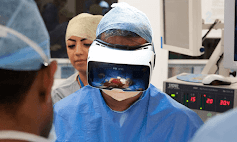VR (Virtual Reality)
Q. What Is Virtual Reality?
Virtual reality (VR) refers to a computer-generated
simulation in which a person can interact within an artificial
three-dimensional environment using electronic devices, such as special Goggles
with a screen or gloves fitted with sensors. In this simulated artificial
environment, the user is able to have a realistic-feeling experience.
The concept of virtual reality is built on the
natural combination of two words: the virtual and the real. The former means
“nearly” or “conceptually,” which leads to an experience that is
near-reality through the use of technology. Software creates and serves up
virtual worlds that are experienced by users who wear hardware devices such as
goggles, headphones, and special gloves. Together, the user can view and
interact with the virtual world as if from within.
To understand
virtual reality, let’s draw a parallel with real-world observations. We
understand our surroundings through our senses and the perception mechanisms of
our body. Senses include taste, touch, smell, sight, and hearing, as well as
spatial awareness and balance. The inputs gathered by these senses are
processed by our brains to make interpretations of the objective environment
around us. Virtual reality attempts to create an illusory environment that
can be presented to our senses with artificial information, making our minds
believe it is a reality.
Application
1.
Entertainment
The potential of VR in entertainment is clear and huge as
the entertainment industry is a multi-billion dollars and consumers are always
interested on its novelty.
The VR video game world was popularized already by the Disney Movie Tron in
1982. Today the video games are explored in large and realism world through an
avatar. In VR games, gamers can look in any direction or walk through the
scene.
Hollywood
movies offers increasing degrees of realism to make user feel like they are
part of the scene. They let the user totally immerse in computer generated
world with the help of HMD that supports a stereoscopic view of the scene
accordingly to the user’s position and orientation enhanced by audio, haptic
and sensory interfaces.
2.
Education
In addition to creating social awareness, the first-person perspective
could revolutionize education scenario we have today. Anything that is too
dangerous, expensive, or impractical to do in reality, virtual reality is the
solution. VR offers visualisation of geometric relationships in difficult
concepts or data that are hard to interpret. If the real environment is costly
or hazardous to health, VR is the best choice to understand and learn it. For
example, flight simulation or firefighting, nuclear power plant safety, medical
procedures etc are the training in VR which are useful for education. Not just
these common uses, VR education includes history, anthropology and foreign
language acquisition. Students can explore the streets in 17th-century, on
different era rather than just reading a book.
3.
Health
VR
technology can also help improve today’s distributed health care system, in
which doctors train to perform routine medical procedures in remote communities
around the world. Doctors can immerse themselves in 3D organ models that were
generated from medical scan data for better planning and preparation for a
medical procedure. It can also be used to explaining the patient and his family
so that they make more informed decisions. VR can also provide therapy to
people suffering from mental illness.
4. Tourism and Advertisment
Virtual Reality has been used to create
histrorical sites, which then enables users to experience it with comfort from
your house. For instance you can even create the war that happened at and
location and feel being in war.





Comments
Post a Comment